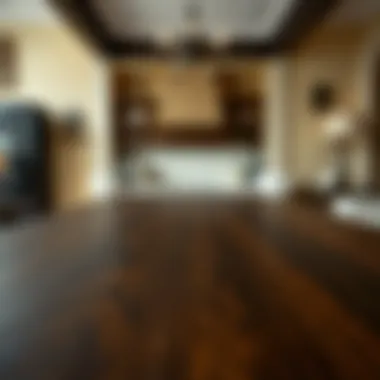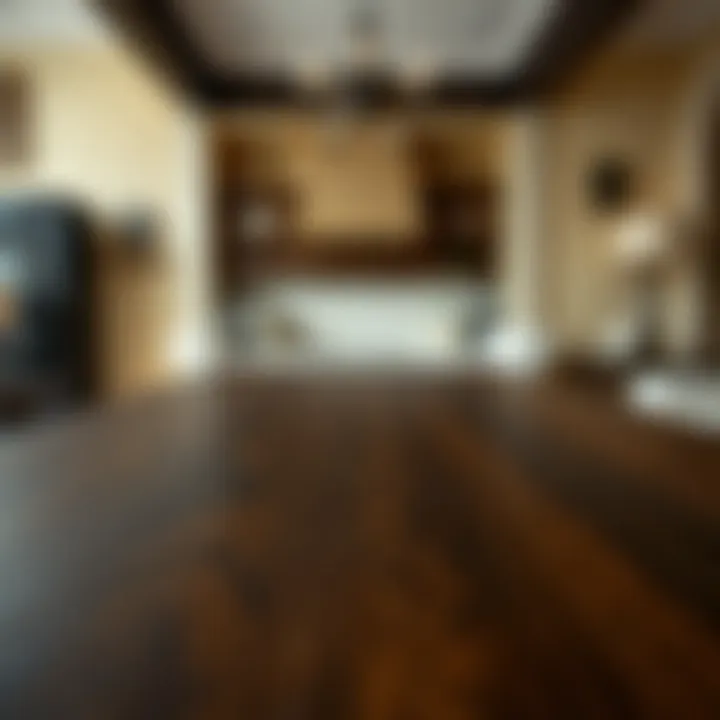Understanding Black and Brown Wood Stains


Intro
Understanding wood stains is crucial for any homeowner, designer, or DIY enthusiast. The depth of color in black and brown wood stains adds a rich character to furniture and decor, allowing for the creation of spaces that are as functional as they are aesthetically pleasing. These stains do more than simply change the appearance of wood; they can enhance the
natural grain, affect the wood's longevity, and even influence the mood of a room.
When we talk about black and brown wood stains, we're entering a realm defined by subtle nuances and significant effects. Imagine the warmth of a dark walnut finish on a dining table, or a deep ebony tone on a cabinetry that commands attention. It’s not just about the visual appeal but also about how these colors can either draw individuals in or make a statement, creating focal points in an otherwise blank canvas of a space.
This article aims to dissect the intricacies of these two popular color families. From preparation techniques to application tips, we'll ensure you walk away equipped with insights that can elevate your staining projects. Let’s explore how the world of black and brown stains can transform wood into a captivating visual narrative.
Understanding Wood Stains
Wood stains are a cornerstone of woodworking and interior design. They enhance the natural beauty of wood, while simultaneously protecting it from the ravages of time. Understanding wood stains is crucial for homeowners, designers, and DIY enthusiasts alike, as it opens doors to creativity and informed decision-making. Whether you’re refinishing an antique piece, crafting new furniture, or even enhancing the look of wooden panels, knowledge about wood stains adequately prepares you for the task at hand.
When we talk about wood stains, we aren't merely referring to the color that fills the pores of wood. It’s about the entire process involving preparation, application, and maintenance. It's not just about aesthetics but also the durability offered to the wood. A deep understanding is essential to match the right stain with the intended project.
Also, one should consider the varying effects that stains can impart on different types of wood. The same stain might appear vastly different on pine compared to mahogany. Thus, understanding these subtleties can mean the difference between a project that shines and one that falls flat.
"A well-stained piece of wood is like a well-tailored suit; it not only enhances the natural beauty but also speaks volumes of the care that went into it."
In summary, familiarizing yourself with wood stains allows for informed choices. It elevates the craft and ensures longevity, allowing projects to speak to their quality and craftsmanship. The next sections will explore what wood stains are and their purposes in woodworking.
Definition of Wood Stains
Wood stains are a type of finish designed to change the color of the surface of the wood while allowing the natural grain to show through. Typically comprised of pigment suspended in a solvent, stains come in a variety of formulations, such as oil-based and water-based. The choice of solvent greatly affects both the application technique and the drying time.
Stains can be clear, enhancing the wood’s natural color, or contain various pigments to achieve a broader palette of hues. Popular colors often include browns, blacks, reds, and grays, appealing to those looking to make bold statements or subtle enhancements.
Purpose of Staining Wood
Staining wood serves multiple purposes:
- Aesthetic Appeal: Stains can drastically change the visual impact of wood, enriching its natural patterns and tones. They allow an individual to express personal style and accentuate design elements in furniture and decor.
- Protection: Beyond looks, stains provide a layer of protection against moisture and UV damage, which might otherwise warp or fade the wood. Certain stains come with additives that increase durability, ensuring that the item withstands the test of time.
- Versatility: Wood stains can be used on a variety of projects—from cabinetry to flooring and even crafted decorations—making them a key tool in a DIY enthusiast’s arsenal. Having knowledge of the type of stain best suited for each specific application not only improves the end result but also helps in easier maintenance.
In essence, stains do more than just add color; they elevate the wood's utility and longevity.
Characteristics of Black Wood Stain
Understanding the characteristics of black wood stain is essential for homeowners, design professionals, and DIY enthusiasts alike. With its dark hue, black stain can dramatically enhance the visual appeal of wood and compliment various styles, from contemporary to rustic. An informed choice of stain impacts not just aesthetics but also the durability and maintenance of the wood surface.
Visual Qualities
Black wood stain bestows a rich, deep tone that can transform the ordinary into the extraordinary. The shade can range from a soft charcoal to an intense ebony, depending on how it's applied. The beauty of black stain lies in its ability to highlight the natural grain of the wood. When applied correctly, it accentuates patterns like oak rays or knotting in pine, adding depth to the overall appearance.
- Reflective Properties: Under different lighting conditions, black stained wood may take on varying nuances, appearing almost glossy in bright light while absorbing shadows in dim settings.
- Versatility: Whether on softwoods like pine or hardwoods like walnut, black stain brings a sense of unity across different materials. With a black finish, any imperfections in the wood grain can either vanish or become an intriguing aspect, depending on your preference for natural textures.
The combination of contrast created by furniture or decor against black stained surfaces also adds a sophisticated touch, opening the door to countless design possibilities.
Effects on Different Woods
The response of black wood stain varies widely across different wood species. The distinct characteristics of each type of wood influence how the stain saturates and highlights the grain. For instance:
- Pine: Due to its softer grain, pine can absorb black stain unevenly but can be smoothed out with careful application. The end result can offer a rustic charm ideal for more casual settings.
- Oak: Known for its prominent grain, oak tends to take on black stain beautifully, showing an impressive depth and contrast that appeals to many homeowners.
- Maple: With its tighter grain, black stain may yield a more uniform appearance that some may find less visually dynamic but perfect for sleek, modern designs.
Understanding these effects can help determine which wood types work best with black stains for specific projects, ensuring the desired integrity of design and durability in the finished work.
Common Uses for Black Stains
Black wood stains aren't just popular by happenstance; their versatility lends them to a bevy of applications. Here are some common uses:
- Furniture: Whether it's a chic coffee table or a rustic dining set, black stain is often chosen for its ability to elevate the overall design.
- Cabinetry: In kitchens or bathrooms, black-stained cabinetry provides a modern twist, frequently used in contemporary or industrial-style homes.
- Outdoor Structures: Patios, decks, and fences find durability with black stains, as they not only provide a sleek finish but also help resist the effects of sun and weather.
"When you choose black stain, you are making a statement—sophisticated yet bold."
In summary, the importance of understanding the characteristics of black wood stain lies in its ability to enhance the aesthetic appeal, reveal the beauty of the wood, and serve various practical needs across applications. A thoughtful application of this powerful stain can enrich any project, creating designs that are both timeless and striking.
Characteristics of Brown Wood Stain
The characteristics of brown wood stain play a pivotal role in both aesthetic and functional applications. Understanding these attributes can greatly influence a homeowner's or designer's decision-making process when it comes to achieving the desired look and longevity for wooden projects. Brown wood stain is often chosen for its warm and inviting tones that can enhance the natural beauty of wood while providing a protective layer. This article will dissect the visual qualities, effects on different woods, and common uses of brown stains, shedding light on why this color choice captivates so many.
Visual Qualities
Brown wood stain can evoke a range of emotions and styles, depending on its shade and application method. The essence of brown lies in its ability to resemble natural earth tones, creating a connection with the outdoors.


- Wide Range of Tones: From light beige to deep chocolate, the variety of brown stains available allows for diverse design preferences. A light oak stain may brighten a space, while a rich walnut can lend a sense of luxury and warmth.
- Enhancing Wood Grain: One of the most appealing aspects of brown stains is their ability to showcase the wood grain underneath. They do not mask the natural characteristics of the wood but complement it, with patterns and textures becoming pronounced. A suitable brown stain can accentuate the intricate knots and flaws that many artisans find attractive.
- Moody vs. Bright Accents: Depending on how it is used, brown can either brighten a room or create a moody effect, depending on the saturation and surface treatment. An espresso stain can offer a dramatic contrast to light-colored furnishings, while a more honey-toned finish can harmonize with warm decor.
Effects on Different Woods
Different types of wood react uniquely to brown stains, and understanding these interactions can make or break a project.
- Softwoods vs. Hardwoods: Typically, softwoods like pine absorb stains more deeply and may darken considerably. This can be a double-edged sword; on one hand, it provides a rustic charm, but on the other, it could lead to unpredictability in final outcomes.
- Oak and Birch: Staining oak with brown stain typically highlights its prominent grain patterns beautifully. In contrast, birch, which has a more subtle grain, may appear bland unless treated properly.
- Impact of Wood Condition: An older, weathered wood may absorb more stain than new lumber. Prepping the surface can help control the staining process, resulting in a more uniform appearance that highlights character without overdoing it.
Common Uses for Brown Stains
Brown wood stains find their way into various applications, solidifying their status as a versatile choice in woodworking.
- Furniture Finishing: Dining tables, chairs, and cabinets often bear brown stain, as its warmth invites users to linger and enjoy. It creates a cohesive look in homes that embrace natural materials.
- Outdoor Structures: Decking and pergolas frequently use brown stains to maintain an organic appearance while also acting as a barrier against the elements. The right stain can withstand moisture and UV damage when appropriately formulated.
- Craft Projects: DIY enthusiasts appreciate brown stains for arts and crafts, as they can elevate small projects, from picture frames to wooden toys, giving them a polished and professional finish.
"Brown stains are not just about color; they embody a philosophy of balance between nature and design."
By considering these characteristics, one can appreciate why brown wood stains are so beloved. They present an opportunity to enhance wood's natural beauty while catering to the practical needs of various projects. Understanding brown stains is essential for achieving excellence in furniture design and home decor.
Comparative Analysis: Black vs Brown Stains
When it comes to choosing between black and brown wood stains, the decision isn't as simple as picking a color off a palette. Each color offers distinct characteristics that can dramatically influence the overall aesthetic and functionality of wood projects. Here, we delve into the crucial distinctions between black and brown stains, exploring their color depth, the impact they have on wood grain visibility, and their suitability for various projects. This comparative analysis not only enhances our understanding of both options but also guides homeowners, designers, and DIY enthusiasts in making informed choices for their specific needs.
Color Depth and Appearance
Black stains have a distinctive appeal, often adding a modern touch while lending a certain depth that can make wood look more refined. The saturation of black stains typically creates a striking contrast against the grain of the wood, which can be both dramatic and elegant. They can turn a simple piece of furniture into a statement piece, catching the eye instantly.
In contrast, brown stains offer a warmer, more natural appearance. They tend to emphasize the wood’s natural colors and textures rather than obscuring them. The depth of brown can vary significantly; from light oak to deep mahogany, there's an entire spectrum that allows for versatility in design. This natural richness often resonates well in traditional and rustic interiors, offering a welcoming touch.
"When choosing between black and brown stains, think about how the color complements your home’s overall aesthetic."
Impact on Wood Grain Visibility
Wood grain visibility is one of the key factors to consider when selecting a stain. Black stains, while bold, can sometimes mask the grain, especially on softer woods. This means that while the surface might look sleek and sophisticated, the natural intricacies of the wood itself can get lost in translation. For certain projects where grain visibility is desired, using black stains may require careful selection of wood types and application techniques.
On the flip side, brown stains excel in showcasing the wood grain. They allow for intricate patterns and textures to shine through, enhancing the natural beauty of the wood rather than concealing it. If you’re working with high-quality lumber, brown stains can truly highlight the craftsmanship by allowing the wood to tell its own story through its grain. This visibility is what often makes brown stains a favored choice for fine furniture and cabinetry, where showcasing the beauty of the material is essential.
Suitability for Various Projects
The suitability of black versus brown stains can hinge on the specific wood project at hand. For example, if someone is revitalizing a contemporary piece or designing a minimalist space, black stains can provide the sleek, chic finish that aligns with modern design principles. It often suits applications such as modern shelving units or contemporary dining tables.
Brown stains, however, work beautifully in spaces aiming for warmth and coziness. They’re an excellent choice for traditional furnishings, rustic barn doors, and cabinetry where a sense of tradition and homeliness is desired. Moreover, projects involving reclaimed wood favor brown stains, as they enhance the weathered characteristics without overshadowing the wood’s history.
Both stains have their unique strengths and applications. Choosing one over the other greatly depends on the end goals, whether it’s a bold, contemporary feel with black stains or a warm, inviting atmosphere with brown stains. Understanding these comparative elements is key to achieving desired aesthetic results in any wood staining project.
Preparation for Staining
Before one even dips a brush into a can of stain, it's crucial to realize that proper preparation sets the cornerstone for a successful project. Staining wood isn't just about choosing a color; it's a fine art that requires an understanding of the wood itself, treatment techniques, and the tools of the trade. If you skimp on this stage, no amount of polish or beautiful stains can salvage a poorly prepared surface.
Choosing the Right Type of Wood
Selecting the right type of wood is akin to choosing the canvas for a painter. Different woods absorb stains differently and showcase them in unique ways. For instance, oak, with its open grain structure, welcomes darker stains like a long-lost friend. It allows the rich color to permeate deeply, enhancing its natural beauty. On the flip side, softer woods may present a challenge; they can soak up too much stain or not enough, leading to an inconsistent finish.
- Types of Wood to Consider:
- Oak: Known for its durability and excellent grain visibility.
- Maple: Absorbs stains differently; may require pre-staining conditioner.
- Pine: Soft wood that can turn splotchy without proper prep.
Before deciding, consider the look you want to achieve. Do you want the grain to shine through, or are you looking for a more solid color effect? Remember, wood types like walnut can provide a stunning look, but they may need a bit of extra love in terms of preparation.
Surface Preparation Techniques
It's not enough to just slap on some stain and call it a day. Surface preparation is everything. This phase directly affects how the stain adheres to the wood. Here are a few techniques:
- Sanding: Begin with medium-grit sandpaper and finish with fine-grit to smooth out any imperfections. Sanding creates a clean slate for the stain to grab hold of. Don't forget to follow the wood grain to avoid scratches.
- Cleaning: Dust and grime can be the bane of a good finish. A clean, soft cloth should do the trick. Wipe down the surface to remove any shavings and oils—you want a pristine canvas.
- Conditioning: Some woods—like cherry and maple—benefit from pre-stain conditioners, which promote even absorption of your chosen stain. Think of it like priming a wall before painting.
These steps may seem tedious, but they make a world of difference in the final appearance of the stained piece. Think twice: a few extra minutes spent here can save a lot of headaches later.
Choosing the Correct Tools
Your tools can make or break your staining endeavor. Note that not all brushes and applicators are created equal. Here are points to ponder when assembling your tool kit:
- Brushes: Opt for high-quality brushes that leave little to no streaks. A natural bristle brush often works better for stains, as it handles the product's viscosity smoothly.
- Applicators: Foam applicators can be a time-saver, especially for large flat surfaces. However, they can soak up too much stain if not used carefully.
- Rags and Cloths: Lint-free cloths are essential for wiping away excess stain. Old t-shirts can work in a pinch, but ensure they are clean—no one wants a mysterious fabric fiber ruining their finish.
Ultimately, your choice of tools greatly influences efficiency and final appearance. A well-prepared setup paves the way for a smoother experience and a more polished end product.
"Preparation might be a tedious chore, but it's the backbone of a successful wood staining project. Take the time to do it right, and you'll reap the rewards."


By taking these preparatory steps seriously, you're planting the seeds for a project that not only looks stunning but also stands the test of time.
Application Techniques for Wood Stains
Applying wood stain isn’t just about slapping on a coat of color; it’s a fine art that can make or break your project. The application techniques you choose can impact not just the final appearance, but the durability and longevity of the finish as well. Mastering these techniques can provide a uniform look, enhance the natural beauty of the wood, and even help conceal imperfections. By paying attention to how you apply stains, whether it’s brushing, spraying, or layering, you can create a stunning final piece that truly reflects your vision.
Brushing vs. Spraying
When it comes to applying wood stains, the choice between brushing and spraying is often a hot topic. Each method has its own set of advantages and disadvantages.
Brushing tends to allow for better control, especially on smaller surfaces or intricate details. The bristles can work the stain into the wood, ensuring thorough penetration. It’s a method that’s more forgiving, as it gives you time to correct any mistakes before the stain dries. However, it can take more time and may require more labor.
On the flip side, spraying offers a quicker application over larger areas. It provides an even coat and less brush mark visibility. However, it also requires good technique to avoid overspray and achieving total coverage. It’s not as simple as point-and-spray; you have to keep a steady hand and move at a consistent speed. Channels of air from the sprayer can sometimes carry stain particles, causing unevenness if not managed properly.
In short, the choice largely depends on the specific project, the wood type, and, of course, your personal preference and skill level.
Achieving Even Coverage
Getting even coverage with wood stains is critical; uneven application ends up being a real eyesore. How can you avoid this? Begin by mixing your stain thoroughly before starting to work. This can help ensure that pigments are evenly distributed and you won’t end up with splotches of color.
One effective technique is to apply stain in sections, especially on larger surfaces. Work from one corner systematically to the opposite end. It helps to use long, continuous strokes. When using a brush, ensure excess stain is knocked off, as too much can lead to runs and drips. Wipe off excess stain after applying with a clean cloth, following the wood grain for smooth finish. If you’re spraying, move in overlapping passes to eliminate gaps, maintaining a consistent distance from the surface.
Layering Techniques for Depth
If you want to add depth to your stained woodpiece, layering is your best bet. This involves applying multiple coats of stain to achieve richer color and texture. However, it’s necessary to wait for each layer to dry completely before adding the next one. Generally, a light sanding in between layers enhances adhesion and provides a smooth finish.
When layering, always start lighter and gradually build towards your desired shade. Test on a scrap piece if possible; that way you can judge how many coats it’ll take to reach that finish you seek. For instance, if going from a light brown to a dark walnut, starting with a lighter undercoat can help transition more subtly without overwhelming the wood’s natural characteristics.
Layering not only affects color but can have an impact on how the wood grain appears. Each additional layer can change the way light interacts with the wood, giving it a more dynamic and interesting look.
"The secret to getting that perfect finish lies in the details of application; it’s the differences between methods that can create something truly unique."
Post-Stain Care and Maintenance
Once a wood staining project is complete, the attention to detail does not end there—rather, it shifts toward post-stain care and maintenance. This stage is crucial as it not only preserves the aesthetic quality of the stained wood but also enhances its longevity. For homeowners, designers, and DIY enthusiasts alike, investing time and effort in proper care can greatly impact the overall durability and appeal of your wood project.
Sealing Stained Wood
Sealing stained wood serves a dual purpose: it protects the underlying stain while simultaneously shielding the wood from environmental damage. Without a good seal, moisture, dirt, and UV rays can cause the stain to fade or deteriorate, leading to an unkempt appearance over time.
- Types of Sealers: Generally, there are two primary categories of sealers—water-based and oil-based. Water-based sealers dry quickly and are easier to clean up, while oil-based ones provide a richer color depth and longer-lasting protection.
- Application Techniques: When applying the sealer, users should opt for a clean brush or roller to avoid streaks. Employing a light hand when applying not only aids in achieving an even coat but also prevents clumping.
- Frequency of Application: As a rule of thumb, checking the sealed wood every few months and reapplying sealer as needed can help keep the color vibrant and the wood protected.
"A stitch in time saves nine"—a little care now can prevent a heap of trouble later in your wood projects.
Cleaning and Care Instructions
Proper cleaning and maintenance techniques are vital to preserving the exquisite look of stained wood. Regular care not only allows the beauty of the wood to shine through but also prevents the build-up of dirt and grime that can affect its finish.
- Gentle Cleaning: Using a soft, damp cloth to wipe the surface is often sufficient. Avoid harsh chemicals, as they can strip the stain or damage the wood finish. For tougher stains, consider a mild soapy solution.
- Avoid Excess Water: It’s important to steer clear of saturating the wood with too much water. Excess moisture can lead to warping, mold, or mildew, which is certainly not the look many desire in their wooden furniture or installation.
- Touch-Up Techniques: Having a small container of the original stain on hand can be beneficial for quick touch-ups. A fine brush or cloth can be used to dab at small blemishes or scratches promptly to maintain integrity.
- Avoid Direct Sunlight: When possible, keep stained wood out of prolonged exposure to intense sunlight. UV light has a knack for fading colors. Window treatments can be useful here, as can strategically placed mirrors to redirect sunlight.
By adhering to these cleaning and care instructions, one can effectively extend the life of stained surfaces. With attention and effort, stained wood can remain a beautifully featured aspect of any space in your home.
Common Mistakes in Wood Staining
Wood staining can be a straightforward process, but it has some nuances that can trip up even the most seasoned DIY enthusiasts or professionals. Identifying common pitfalls not only spares your wood from unwanted blemishes but also elevates the overall quality of your project. You want the beauty of the wood to shine through once all is said and done. A keen understanding of these missteps can ensure the stain application goes off without a hitch, enhancing both the appearance and longevity of the wood. Below, we’ll delve into two critical mistakes to watch out for.
Over Application of Stain
Applying too much stain might seem like a good way to achieve that deep, rich color. However, it often leads to more harm than good. Over application can create a sticky, uneven surface that attracts dust and dirt, making maintenance a headache. When you load your brush too heavily or apply multiple thick layers, you might end up with a blotchy finish, hiding the wood grain instead of allowing it to shine.
One commonly overlooked issue is that excess stain doesn't just evaporate—it can also pool in corners or on flat surfaces, resulting in unsightly drips. This pooling effect requires touch-ups and extra finishing work, ending up being counterproductive. Here are some practical tips to avoid over application:
- Use a Lint-Free Cloth: When applying, opt for a lint-free cloth or a foam applicator instead of a traditional brush. This allows for more control and even distribution.
- Follow the Manufacturer's Recommendations: Every stain has specific application tips. Following instructions can save you from making a mess.
- Work in Small Sections: Tackling your project in small sections helps you manage the amount of stain you apply effectively, reducing the chance of overdoing it.
"Less is often more when it comes to wood stain application. Carefully gauge the amount to achieve a polished look."
Ignoring Wood Condition
Neglecting to assess the condition of the wood can lead to frustrating results. The surface you're working with plays a crucial role in how the stain will react and look once cured. Whether the wood is new, reclaimed, or has been previously finished, each scenario demands different attention before staining.
For newly cut wood, it's essential to allow it to acclimate to your environment. If it's too dry, it might absorb stain unevenly. Conversely, old wood could harbor remnants of previous finishes, dirt, or grease. You might think sanding will fix everything, yet under-prepping can cause the stain to raise the grain or produce a splotchy finish. Here are key considerations for wood condition:
- Inspect for Damage: Look for cracks, chips, or knots. Repairing these before you stain will give you a smoother finish.
- Sanding is Key: Always sand your wood with the right grit. Starting with a coarser sandpaper and finishing with a fine one is usually the best approach.
- Clean the Surface: Sweep away dust and debris. If the wood has been stained before, consider stripping the old finish completely for a fresh start.


By taking the time to assess the condition of your wood, you’re ensuring that your stain performs to the best of its ability, leading to a final product you can be proud of, without unsightly surprises.
For further reading on wood care and finishing, you might find this resource useful.
Innovations in Wood Staining Technology
In the realm of wood finishing, innovations in staining technology mark a significant turning point. Gone are the days of basic, single-color stains that offer little flexibility. Today's advancements are transforming how homeowners, designers, and DIY enthusiasts interact with wood. The emphasis now lies not only on aesthetics but also on the longevity and environmental impact of the finishes applied.
Advanced Stain Formulations
The future of wood stains is driven by advanced formulations that incorporate various elements to enhance performance. These new products often combine the rich pigment needed for deep coloration with enhanced adhesion and durability. For example, water-based stains have gained popularity thanks to their ease of use and quick drying times. They also have lesser fumes than oil-based options, making them safer for indoor use.
These advanced formulations often utilize technology that improves penetration into the wood, allowing for better color saturation without obscuring the grain. Consider the difference between a run-of-the-mill stain and one that contains pigments engineered to react with the tannins in wood. The latter can provide a striking, depth-filled finish that seems to emerge from within—rather than just sitting on the surface.
Moreover, some stains are now equipped with UV blockers, significantly extending the life of the finish against sun exposure. For homeowners wanting to keep their wooden furniture or decks looking new, this can be a game changer.
Eco-Friendly Stain Options
With a growing awareness of environmental issues, eco-friendly stains are taking center stage in the wood finishing industry. These stains are crafted with biodegradable ingredients that do not compromise on quality or performance. Homeowners can now achieve beautiful finishes without the guilt of harming the environment.
Eco-friendly options often come in both oil and water-based forms. For instance, stains made with plant-derived solvents not only cut down on harmful emissions but also provide a rich and vibrant finish. The rise of these products indicates a significant shift towards sustainability in wood staining.
Using eco-friendly stains allows DIY enthusiasts to embark on projects with a clear conscience. Knowing that their finishes are safe for their families, pets, and the planet is a powerful motivator for many.
“Innovation in stain technology means homeowners no longer have to choose between looks and environmental responsibility.”
Case Studies in Wood Staining
Case studies provide critical insights into the practical application of black and brown wood stains. They allow us to examine real-life examples where these stains have been utilized effectively, illustrating their impact on both aesthetics and functionality in various projects. For homeowners, designers, and DIY enthusiasts alike, understanding these cases can be invaluable. It highlights the versatility of wood stains in different settings, helping to visualize potential outcomes and best practices.
By delving into case studies, readers can learn about not just the process of using these stains, but also the reasoning behind specific choices made in each project. This includes considerations of wood types, stain formulations, and application techniques, ultimately leading to informed decisions in future staining endeavors.
Successful Projects with Black Stain
When we think about the appeal of black stain, the mind often wanders to modern and sleek aesthetics. One such project that stands out is the renovation of an old wooden dining table. The darkening effect of black stain transformed this piece from a faded relic into a stunning centerpiece that instantly upgraded the dining room's ambiance.
- Wood Type: In this case, a reclaimed oak was used. The natural grain was enhanced by the black stain, allowing the texture to shine through while bringing a contemporary look.
- Application Method: The homeowners chose to apply the stain using a foam brush. This method resulted in a smooth finish, avoiding brush marks commonly seen with traditional bristle brushes.
- Outcome: The transformation not only raised the aesthetic bar but also made the table more resilient to wear and spills, showcasing how black stain can balance beauty and functionality.
Cultural Perspectives on Wood Stains
Understanding how cultures influence the selection and application of wood stains enriches the conversation around wood finishing. This section delves into the historical significance and current trends associated with dark stains, particularly black and brown, illustrating their aesthetic and cultural importance. Recognizing these perspectives not only adds depth to design choices but also invites a broader appreciation for craftsmanship in woodworking.
Traditional Uses of Dark Stains
Throughout history, various cultures have adapted dark wood stains for numerous practical and aesthetic reasons. For example, in China, traditional furniture often features dark stains, which symbolize elegance and focus on deep, rich tones that complement intricate detailing. Dark finishes often evoke a sense of grandeur and maturity, common in furniture crafted during the Ming and Qing dynasties.
In contrast, Scandinavian design highlights the warmth of dark stains against light woods, achieving a modern yet coozy feel. The harmonious blend of dark hues with natural wood grain can elevate simple pieces to centerpieces. These traditional applications convey not just artistic merit but also convey a cultural identity and collective memory towards craftsmanship.
In some regions, dark stains also serve practical functions. They can enhance the durability of furniture meant for outdoor use, particularly in areas where ultraviolet radiation affects hardwood. Additionally, in agricultural societies, certain dark stains are derived from local natural resources, reflecting community characteristics and environmental practices.
"Wood stains are not just about color; they often tell a story rooted in tradition and identity."
Modern Trends in Staining Techniques
Today’s wood staining techniques have evolved, merging tradition and technology. One key trend is the growing preference for eco-friendly stains that minimize the use of harsh chemicals, respecting natural resources while still achieving that coveted deep finish. Water-based stains are gaining traction, offering fast drying times and reduced toxicity, making them a popular choice among environmentally conscious homeowners and designers alike.
Moreover, contemporary design emphasizes transparency in the staining process, with techniques that underscore the natural beauty of the wood grain rather than masking it. This shift reflects a broader cultural move towards sustainability and authenticity in design choices.
Another trend includes the use of mixed media, where stains are combined with paints or even waxes to create unique finishes. The experimentation with texture and color not only showcases individuality but also aligns art with the craft of woodworking, pushing boundaries beyond traditional aesthetics.
In summary, the cultural perspectives on wood stains show how these choices are steeped in history yet dynamically suited to current trends. Understanding the significance of traditional and modern applications informs better decision-making for homeowners, designers, and DIY enthusiasts.
Epilogue
Understanding the nuances of black and brown wood stains is not just a creative endeavor but a strategic step for homeowners, designers, and DIY enthusiasts alike. The choice between these two stain families can greatly influence the aesthetic and functionality of woodwork, making the conclusion of this article pivotal in summarizing the core insights.
Recap of Key Insights
- Visual Impact: Black stains bring a touch of elegance and can amplify contrast, highlighting details within the wood grain. Brown stains, on the other hand, provide warmth and a more natural look, resonating with earthy tones.
- Effects on Wood: Different woods react uniquely to these stains. For example, oak can appear more vibrant with black, while walnut often benefits from brown, preserving its rich undertones.
- Application Techniques: Knowing how to apply these stains is crucial. Techniques like brushing or spraying will yield varying results, affecting the final appearance and texture.
- Maintenance Considerations: Regardless of the stain chosen, proper sealing and care are necessary for longevity. This ensures that the beauty of the wood remains intact through time.
This comprehensive overview highlights that the interplay of color, wood type, and application methods is of utmost significance. Making informed decisions based on these details can lead to successful and satisfying staining projects.
Final Thoughts on Choice of Stain
Choosing between black and brown wood stains is more than just a matter of preference; it’s about aligning your project with your overall design vision. Black stains might be your go-to for a sleek, modern look, especially if you want to create a dramatic effect or bring a more contemporary edge to classic wood pieces. Conversely, opting for brown can enhance the natural lines and textures of the wood, providing a timeless finish that complements various styles from rustic to traditional.
In making your choice, consider these factors:
- Project Type: Different projects call for different aesthetics. For a coffee table, a rich brown may suit a rustic vibe. For a modern bookshelf, black could elevate the overall design.
- Environment: If the stained piece is within a well-lit room, black can absorb more light and serve as a focal point. In contrast, brown can blend seamlessly with existing decor.
- Longevity: Reflect on maintenance and wear. Lighter brown stains may show scratches more easily than black, influencing the decision based on the expected usage of the item.
Ultimately, whether you lean towards black or brown wood stains, it's essential to approach the project with an understanding of how the colors will interact with the wood and your broader design intentions. In forging this relationship, you fortify both the aesthetic appeal and the durability of your woodwork.















